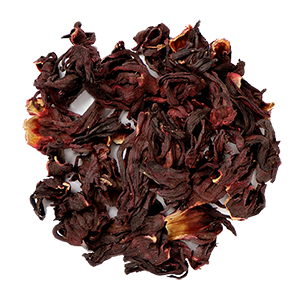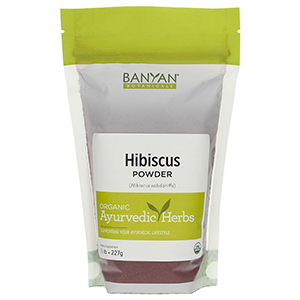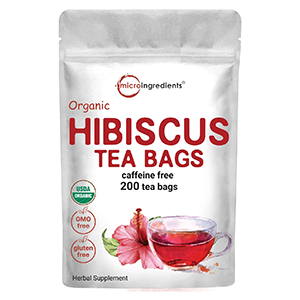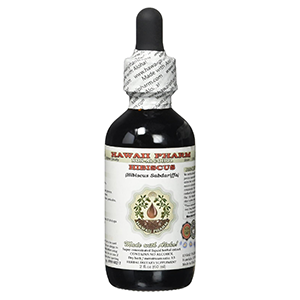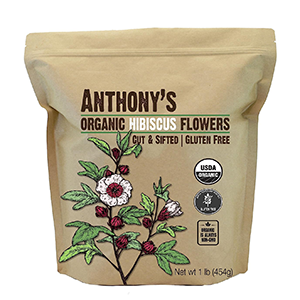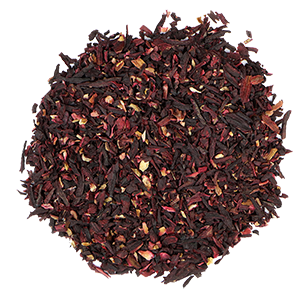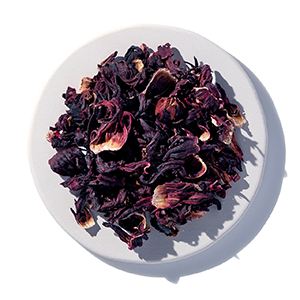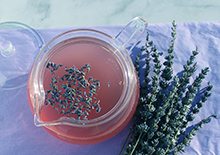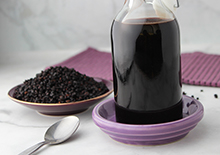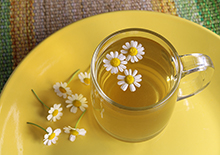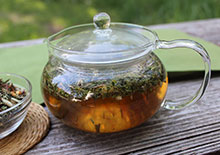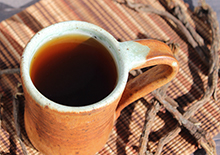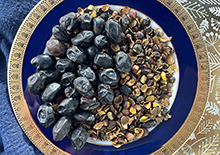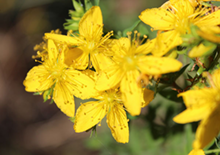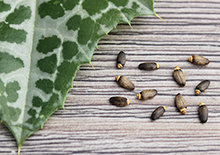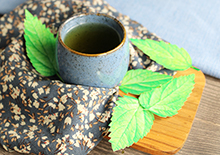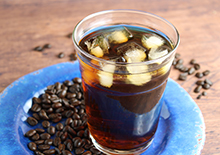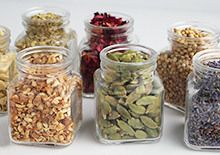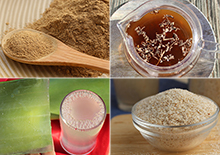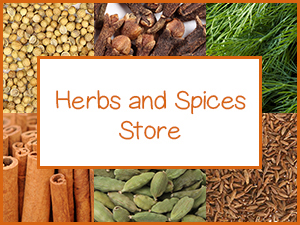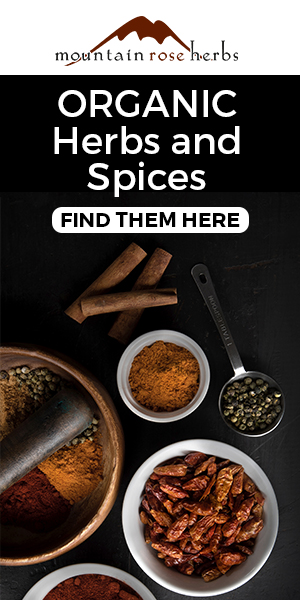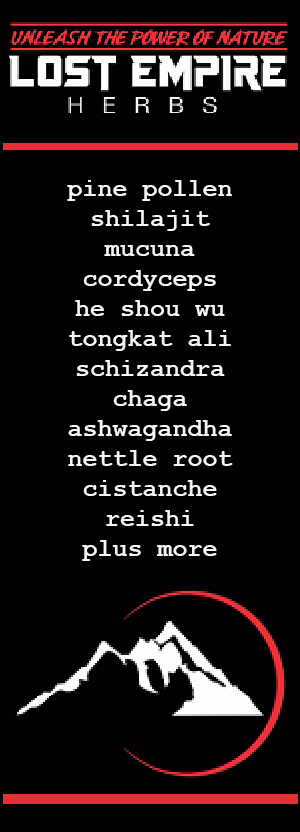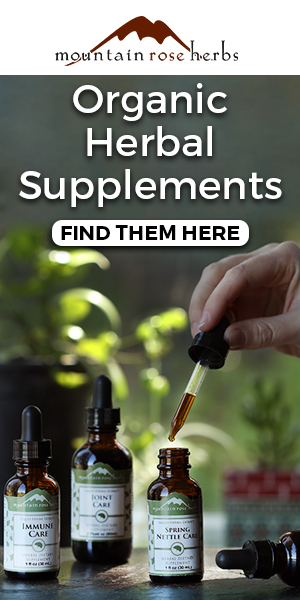- Home
- List of Herbs
- Benefits of Drinking Hibiscus Tea
Benefits of Drinking Hibiscus Tea, What Daily Use Can Do
What is Hibiscus? | Top 8 Benefits | How to Make Hibiscus Tea | Other Ways to Take Hibiscus | Precautions | Shop
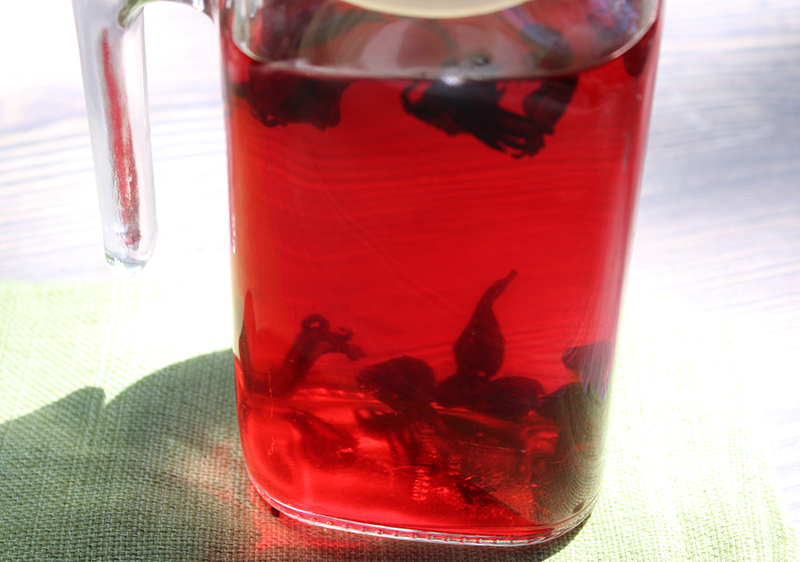
The benefits of drinking hibiscus tea, which we will shortly discuss, come from the main Hibiscus sabdariffa or "roselle" species most commonly utilized for hot water or sun tea infusions.
The classic tropical-looking white, pink or red hibiscus flower has 5 broad ornate petals with an extended center pistil and many stigmas.
The tea itself, however, is NOT made from these dried flowers as one might assume, but from what is called a flower calyx.
Table of Contents
What is Hibiscus? | Top 8 Benefits | How to Make Hibiscus Tea | Other Ways to Take Hibiscus | Precautions | Shop
This is the part that develops from the blossom as an accessory fruit and further matures over several months turning a deep ruby-red color.
When these dried hibiscus calyces are steeped as a tea they infuse the water with their brilliant pigmentation.
Hibiscus tea can be a delicious tangy hot beverage or a thirst-quenching cold drink, but this infused liquid also offers many benefits to the body when incorporated into one's daily herbal tea regime.
Top 8 Hibiscus Tea Benefits
1) For High Blood Pressure
High blood pressure, or hypertension, is a
common condition worldwide which can lead to more serious health
issues if not addressed. It is therefore good to have it checked
regularly.
The blood normally presses against the walls of the arteries as it circulates throughout the body. High blood pressure is when this force of action is persistently elevated, causing an extra burden on the heart.
There are a few food/herb sources that are remarkably useful as blood pressure-lowering allies and anthocyanin-rich hibiscus is top on this list.
In addition to a low-salt high fiber diet, drinking 2 cups of hibiscus tea a day has been shown to positively influence both systolic and diastolic blood pressure levels in both humans and animals. This is especially the case if you fall into the two categories called prehypertension or Stage 1 hypertension. (*)
It's essential however to consult with your physician if hypertension is a major and/or chronic health concern.

Dehydration is something that can also increase the risk of high blood pressure. Along with adequate water intake, drinking hibiscus tea can simultaneously ensure the body is well-hydrated.
One way to tell if you're dehydrated is the color of your urine. Dark yellow is an indication you need to consume more water and supplementing with hibiscus tea is a tasty way to do just that. Plus, the hibiscus calyx is a source of calcium salts, vitamin C helpful for fluid uptake.
It likewise works well for those with hypertension who tend to get overheated, as hibiscus is naturally cooling to the body.
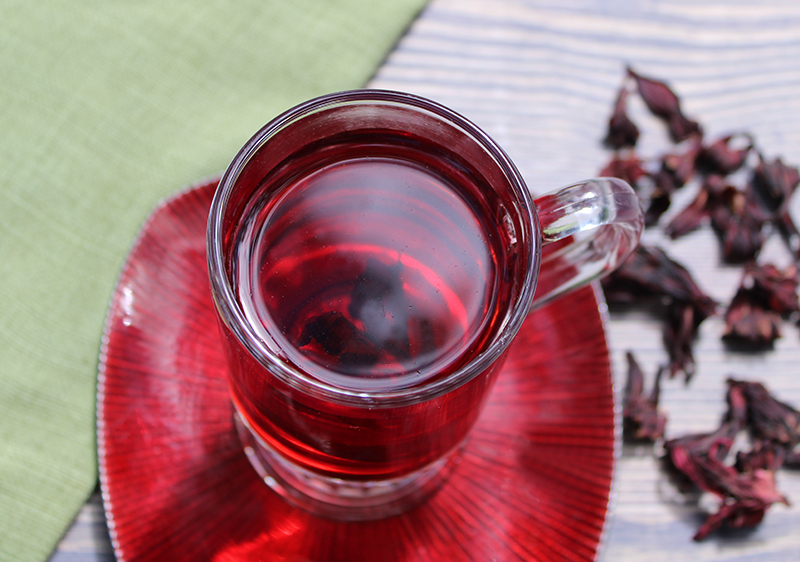
2) Supports Balanced Cholesterol
Hibiscus sabdariffa calyx extracts and their active phytochemicals like ANTHOCYANINS, POLYPHENOLS and HIBISCUS ACID have been identified to foster balanced cholesterol levels, adding to their antihypertensive influence. (*)
In research, a significant reduction of low-density lipoprotein or LDL, sometimes deemed "the bad cholesterol" has been observed with hibiscus intake. (*)
Maintaining balanced cholesterol levels is intimately linked with reducing risk factors for things like coronary artery disease and is essential for cardiovascular health in general.
Consuming a cup or two of hibiscus tea might be a beneficial adjunct to add to the daily diet for such purposes.
In Ayurveda, brightly colored hibiscus flower teas and powders are known to be energetically uplifting to the heart both physically and spiritually. In other ethnobotanical healing systems, hibiscus is often utilized with hawthorn berries as cardiac tonics.
3) Protects Against Candida
One of the major health benefits of drinking hibiscus tea is its use as an antimicrobial agent. Again, HIBISCUS ACID is found to be the compound responsible.
It is shown in some science to help inhibit the overgrowth of Candida albicans causing what is medically termed candidiasis. This is when candida becomes the dominant species significantly outnumbering other microflora in the gut microbiome.
Over time a systemic candida yeast/fungal infection can cause indigestion of food as well as contribute to various gastrointestinal diseases like irritable bowel syndrome and leaky gut.
Although candida is normally a common intestinal yeast that is naturally present in the body, under unhealthy circumstances or when the body is immunocompromised it becomes a low-grade pathogen.
Along with a low-sugar diet, hibiscus teas or extracts might be a great alternative therapy to assist in the healing process.
4) For Obesity and Weight Loss
Hypertension, diabetes and cardiovascular disorders are often issues associated with obesity. Drinking steeped hibiscus flower tea might be a beneficial beverage option to consider if weight loss is a health objective.
The satisfying tart cranberry/cherry-like taste can make it a great replacement for high-calorie sodas when the craving arises.
Likewise, hibiscus is reviewed for its therapeutic potential for type 2 diabetes.
Hibiscus calyces get some of their health-enhancing qualities from the compounds like BETACYANIN and ANTHOCYANIN responsible for the dark ruby-red pigmentation.
They also contain other bioactive components like POLYPHENOLS, POLYSACCHARIDES, PECTIN, GLYCOSIDES and ORGANIC ACIDS including malic, citric and tartaric acids. These acids give hibiscus its sour taste, which is why hibiscus tea is also called "sour tea" in some countries.
Sour drinks can also assist with the digestion of foods, benefit bowel regularity and prevent constipation.
5) Kidneys and Reproductive Health
Hibiscus has a long history in the traditional medical system of Ayurveda and is used therapeutically to support the lower region of the body.
It is viewed as useful for kidney functions, healthy urinary flow as well as used for the female reproductive system and menstruation cycles. It is not, however, recommended during pregnancy.
In some modern research on rats, hibiscus has been shown to possess "anti-urolithiatic" activity or reduce the formation of kidney stones.
The red hibiscus is the flower of the Hindu Goddess, Kali and is also closely allied with Ganesh, the elephant-headed god known as the "Destroyer of Obstacles". In Indian culture, the energy of Ganesh is likewise associated with the first and second chakras or lower regions of the body.
6) Cooling to Urinary System and UTIs
One of the great benefits of drinking hibiscus tea is that it has a cooling anti-inflammatory effect on most humans who consume it.
Teaming up with the kidneys as part of the urinary system, hibiscus tea can help to cool a burning urinary tract infection.
Hibiscus tea or "roselle drink" was observed to lower the incidence of UTIs in long-term care facilities.
Ayurvedically speaking, the taste of hibiscus is considered mostly sweet and astringent. It is therefore viewed as balancing for Pitta and Kapha conditions but may increase Vata when used in excess.
7) Skin and Liver Support
Hibiscus and its many antioxidative and antimicrobial compounds can help purify the blood and remove toxins from the body. This effect naturally promotes liver health and encourages clear and glowing skin from the inside out.
Hibiscus flower is a commonly utilized ingredient in beauty care products for the skin, scalp and hair.
The polyphenols found in hibiscus may also offer a liver-protecting quality for obese individuals with liver steatosis or a non-alcoholic fatty liver.
8) Other Benefits
Because of its therapeutic antioxidant and anti-inflammatory potential, drinking 1-2 cups of hibiscus tea a day can also support immune health and provide neuroprotective properties.
Hibiscus Tea Recipe
This is a basic hibiscus tea recipe using bulk flower calyces.
In a jar or teapot, infuse 1/4 cup of dried hibiscus flowers into one quart (32 ounces) of hot water.
(This is the equivalent of one tablespoon for every cup of water.)
Allow this to steep with a lid for about 20 minutes.
Or this recipe also makes a great sun tea infusion, steeped in full sun for several hours.
Hibiscus tea is typically sweetened to balance out the tart flavor. We like to use raw honey, maple syrup and/or a little stevia. Likewise, licorice root can also be infused with the flowers for added sweetness and full-bodied flavor.
While you can drink it hot, it is commonly refrigerated and served as a cold or iced tea, a bit like lemonade.
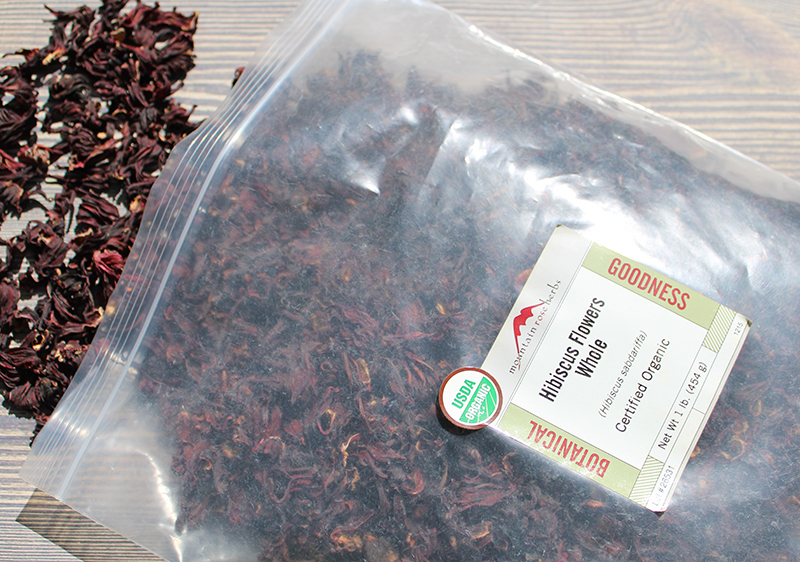
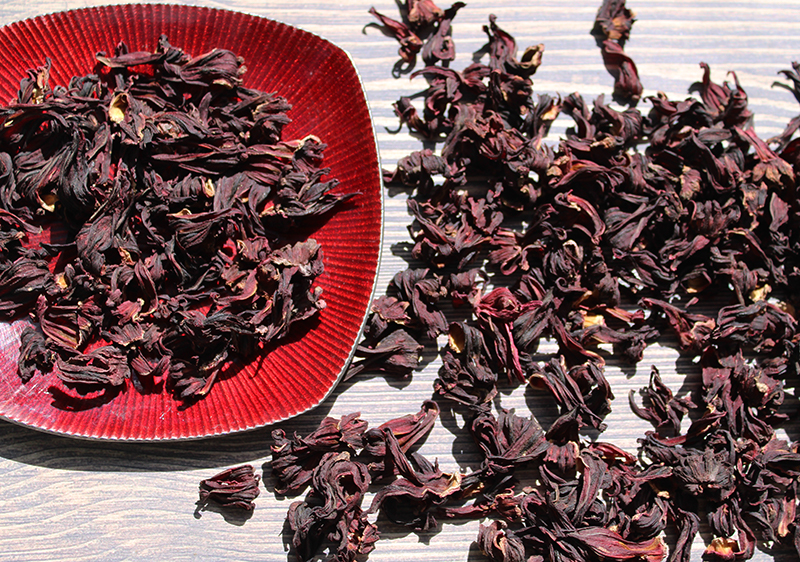
Other Ways to Take Hibiscus
Definitely, the most popular worldwide way to use dried hibiscus flower is by making hibiscus tea. Hibiscus tea bags are also offered by some suppliers for convenience.
Hibiscus flower calyces are available as a powder which can be infused in hot water OR they can be used when making DIY body care products.
Some brands opt for providing hibiscus in the form of a liquid extract, but capsules and tablets are less common.
Precautions:
The benefits of drinking hibiscus tea are usually well-tolerated by most people. Excessive amounts however are not recommended. Avoid if pregnant or nursing and consult your health care provider if you have high blood pressure, are taking any medications or have other serious health conditions.
Shop Related Products (About Affiliates & Amazon Associate Paid Links)
Affiliate Disclaimer: This section contains affiliate product links. If you make a purchase through our recommended links, we receive a small commission at no additional cost to you. Thanks for the support.
